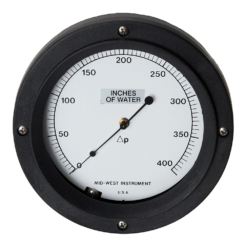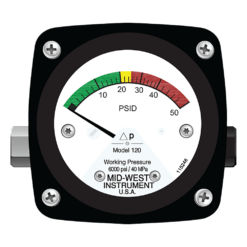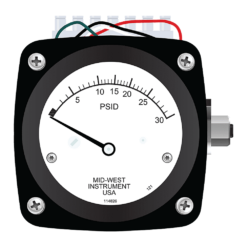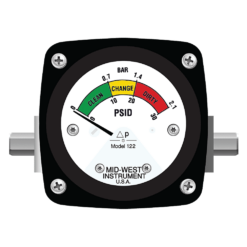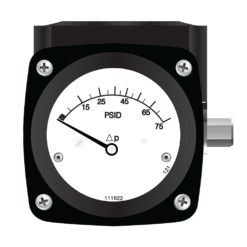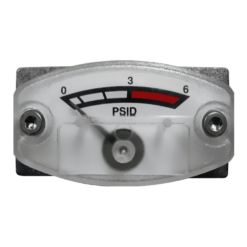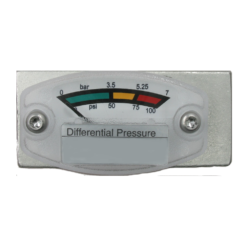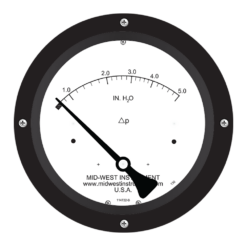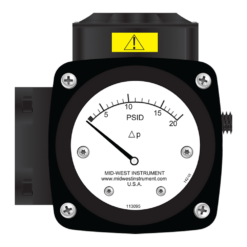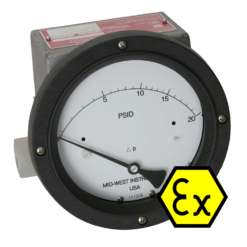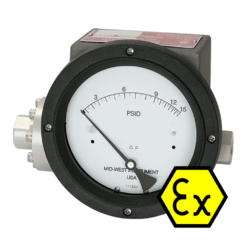Pressure Measurement
ABLE Instruments & Controls offer an extensive range of pressure measurement products including pressure switches, pressure transmitters & pressure gauges. Choose from United Electric, Mid-West or Rotork Schischek or Siemens.
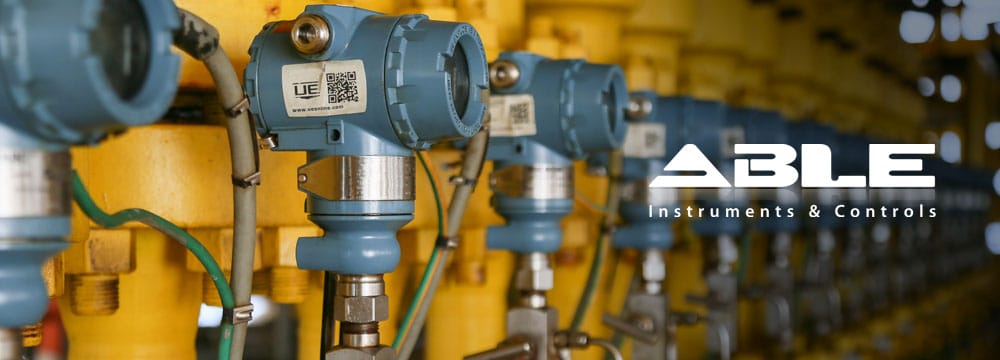
Pressure sensors play critical process and quality control roles in industrial applications. The Industrial market covers a broad scope of applications that range from very low vacuum (negative pressure) and very low pressure (around 1-IN H2O or less) to very high pressure (10,000 psi or more). In addition to the pressure range, engineers must consider several parameters to select the appropriate pressure sensor. The desired measurement media and application packaging requirements are next step considerations in the sourcing process.
Pressure Measurement
Accurately measuring liquid, gas, and steam pressure is a basic requirement for many industrial processes to operate safely, efficiently, and with optimum quality control. In addition to directly measuring pressure values, pressure measurements can be used to determine or infer flow rates, fluid levels, product density, and other parameters. As a result, many plants rely on pressure-measurement devices to get required field measurements.
For example, if a constriction, such as an orifice plate, is placed in a pipe, pressure will drop in a predictable way. By measuring the pressure in the pipe both before and after the orifice plate, the rate of flow through the pipe can be calculated.
Absolute, gauge, and differential pressure
Pressure-measurement devices can be categorized according to the measured reference pressure. The three reference pressures are:
- Absolute: Absolute pressure measurements compare measured pressure to a perfect vacuum (0 pounds per square inch, absolute [psia]).
- Gauge: Gauge pressure measurements compare measured pressure to the pressure of the surrounding atmosphere (approximately 14.7 psia) as a reference pressure. Changes in atmospheric pressure (such as those due to changes in the weather) are taken into account for the output of a gauge transmitter. Gauge devices are often used to measure level in holding tanks that are open to the atmosphere.
- Differential: A differential pressure measurement uses a second process pressure as a reference pressure. Differential pressure measurements are often used to infer the rate of flow through a pipe by determining the pressure drop that occurs from one point in a system to another, such as the drop that occurs across an orifice plate in a pipe.
Pressure sensors and transmitters have been used in the process industry for decades, starting in the 1940s with pneumatic transmitters that supplied a pressure signal to pneumatic controllers. In the 1950s, electronic transmitters appeared, which converted the pressure signal to a 4–20 mA signal that could be used by electronic controllers and, later, by computers. HART was added to the 4–20 mA signal in the 1980s, creating the smart pressure transmitter. Fieldbus digital signals came later, and now wireless is available in both types of smart transmitters.
Smart transmitters allow more than just the pressure value to be reported from the field. Now a significant amount of information can be reported from a single pressure transmitter. One of the most important advances of smart transmitters is in the area of diagnostics.
Most smart pressure transmitters include a basic set of diagnostics that notifies the operator when the device is broken or needs to be serviced. Today’s more advanced smart transmitters provide additional diagnostic insights not only into the state of the transmitter, but also into the electrical loop and process itself, issuing proactive alerts so operators can respond immediately and avoid downtime. New advances in diagnostics include:
- Process monitoring: Pressure transmitters can listen to the background noise of a process and detect deviations from normal operation that could signify plugged impulse lines or more serious issues with the process itself, such as distillation column flooding, flame instability, or pump cavitation.
- Loop monitoring: Diagnostics can monitor the integrity of the electrical loop that connects a field device to the control room to notify operators of any irregularities such as water in housings and junction boxes, wire corrosion, or unstable power supplies.
Going Wireless
Traditional wired pressure transmitters require a supporting infrastructure including wire, cabling, conduit, junction boxes, marshalling cabinets, and I/O to transmit the pressure signal back to the control system. This infrastructure sometimes makes it too difficult or expensive to install pressure transmitters in certain locations.
Installing and implementing wireless devices can take up to 75 percent less time than traditional wired devices with the elimination of wiring and construction labour, and the capital costs associated with wireless technology can be up to 40 percent less. In addition, the insights gained from added pressure monitoring points can help extend the life of assets, creating an even greater return on investment. With a battery-powered wireless pressure transmitter, measurements can be made and transmitted anywhere a pressure transmitter can be installed in a pipe, tank, or steam line for flexibility in a variety of applications.
Liquid vs Gas Pressure
The factors that influence the pressure of a liquid are different from the factors that influence the pressure of a gas. When measuring pressure, it is important to understand the pressure properties of liquids and gases. The hydrostatic pressure exerted by a liquid is influenced by three factors:
- Height of liquid in a column
- Density of the liquid
- Pressure on the surface of the liquid (vapour space)
The pressure at the bottom of a column of liquid increases as the height of the liquid in the column increases. Pressure is affected by the height rather than the volume of a liquid.
Unlike a liquid, a gas exerts equal pressure on all parts of the container in which it is held. Two factors affect the pressure exerted by a gas:
- Volume of the container in which the gas is held
- Temperature of the gas
An electronic/digital connection between two pressure transmitters in a dP level system helps eliminate problems with impulse lines, such as temperature effects, clogging, or freezing in the winter.
Ideal gas law: PV = nRT
Gas pressure is affected by changes in temperature. If the volume of the vessel holding a gas and the amount of gas are unchanged, the pressure exerted by the gas on the vessel walls will change in proportion to changes in the temperature of the gas. Or simply stated, by measuring the pressure and temperature in the tank, you can measure the gas.
Measuring Flow
A common use of a pressure measurement is to infer a fluid’s flow rate through a pipe. As a fluid flows through a pipe restriction, the fluid pressure drops. The pressure of the fluid flowing through a pipe is greater on the upstream side of the restriction and lower on the downstream side.
If pressure is measured before and after the restriction in the pipe (e.g., a flow element such as an orifice plate, venturi tube, flow nozzle, wedge, or annubar), the square root of the pressure drop is proportional to the flow rate of the fluid through the pipe.
Approximately half of all flow measurements are made by inferring the flow rate from a differential pressure measurement.
Measuring Level
The level of a liquid in a tank or vessel can be determined from a pressure measurement by this equation:
height = pressure/liquids specific gravity
Closed tanks or vessels need a dP transmitter to account for the vapor space pressure. Open tanks or vessels need an absolute pressure transmitter or a dP transmitter with the low-pressure side vented to the atmosphere.
Because hydrostatic pressure is directly proportional to the height of the liquid, differential pressure measurements can be used to report levels.
Measuring Density
Pressure is equal to the height of the column of liquid being measured multiplied by the specific gravity of the liquid. Therefore, if the height of the column is a known constant, as in the case of the distance between two pressure-measurement points on a vessel, the density can be inferred from the pressure reading using the following equation:
specific gravity = pressure/height of liquid (level)
Specific gravity values can then be converted to density or mass-per-unit-of-volume units such as grams per cubic centimetre. Density measurements are often used in the brewing industry to determine stages of fermentation.
Even after decades of use in industrial applications, pressure measurement technologies continue to advance. These advancements make traditional measurements easier, and often allow measurements in areas where they were not possible before.
Typical Industrial Applications
Factory Automation:
Pressure transducers may be used in several factory automation applications, including:
- Production/process equipment
- End-of-line testers
- Leak detection systems
- Product/material test machines
Transportation:
Pressure transducers can be used for transportation assembly and assembly test applications, such as:
- Automated paint systems
- Automated sealant dispensing systems
- End-of-line leak testing stations
- Oil pump testing
- Cold engine testing for possible leaks or imperfections
- Fuel injection system pressures
- Vehicle fluid fill control pressures
Injection Blow/moulding Machines:
In injection/blow moulding machines, it’s important to monitor for even flow and prevent bursting. Pressure transducers can be used to:
- Monitor the amount of pressure forced into the injection
- Measure to prevent bursting from too much pressure
- Control material dispensing or forming
Packaging Machines:
With packaging machines, transducers monitor pressure as the bag/pouch is filled; once a specific pressure is reached, the machine stops either sealing or filling the bag. Pressure transducers can monitor bag inflation, nitrogen purging, leak detection, or sealing integrity.
Semiconductor Manufacturing:
Through measurement of airline pressure, sensors provide mechanism control during grinding with go/no-go feedback to stop the process if there’s a manufacturing problem, thereby, reducing scrap as the sensors stop the process. Pressure sensors can deliver process control during the manufacturing process (grinding, cleaning, etc.) of silicon wafers.
Aerospace Test & Research Labs:
Subcontractors test and certify hydraulic systems before shipping to the aerospace manufacturer as part of the acceptance testing for product quality control. Test validation assures that the systems are properly functioning through the collection of data, control data, and validation results. Pressure transducers play an important role in measuring and certifying the flow and rate of the hydraulic fluid within the aircraft actuator being tested, and may provide design validation such as testing an air wing or other subassembly aspects on aircraft or systems by monitoring various pressure lines.
Vehicle:
In the rugged industrial manufacturing environment, vehicle health and maintenance are important. Pressure sensors can help monitor:
- Oil pressure
- Coolant pressure
- Fuel flow, consumption, flow, and pressure
- Intake air flow
- Manifold vacuum testing
- Transmission pressure testing
- Engine and emissions testing
Component Testing:
To ensure quality, pressure transducers can be used in component testing for the following:
- Fluid pump pressure
- Brake system testing
- Tire manufacturing mould pressure control
- Air bag system testing
- Suspension pressure
- Hydraulic pressure testing
ABLE Instruments & United Electric Controls – a 35-year relationship
United Electric Controls (UE) provides safety, alarm, and emergency shutdown solutions (ESD) that reduce complexity, simplify installation, and achieve regulatory compliance. The company provides wirelessHART gas leak detectors, pressure switches, temperature switches, electronic smart switches, safety switches, safety transmitters, and sensors for the process, discrete, semiconductor, aerospace, and defence industries.

United Electric Controls (UE) provides temperature switches, pressure switches, electronic pressure switches, differential pressure and temperature transmitters, wireless gas detectors, temperature sensors, and controls for critical safety, alarm and emergency shutdown (ESD) functions demanded by the process industries and mission-critical applications.
With over 80 years of knowledge designed into their application-specific products, customers are assured of out-of-the box performance and reliability.
UE’s smart electronic temperature switches and pressure switches combine a switch, gauge, and transmitter in a rugged instrument with no moving parts. They go beyond the mechanical switch to eliminate operating risk and increase system reliability.
SIL Certified Products:
UE manufacture many different SIL 2 certified products. Their products are designed with safety in mind, and they offer sensors that are certified to IEC 61508 standard. The UE product portfolio has 4 SIL 2 certified and SIL 3 Capable products, the 12 Series, the 100 Series, the One Series Field Safety Transmitter and the 120 Series.
The One Series Safety Transmitter is a pressure or temperature monitoring transmitter switch that provides a NAMUR NE 43 standard 4-20 mA analog output. Its programmable high-capacity solid-state safety relay output enables the fastest emergency shutdowns.
The One Series Safety Transmitter is certified for use in SIL 2 functional safety applications (HFT = 0) and is capable of SIL 3 applications when augmented by redundancy and voting logic. Its simple design means fewer nuisance trips — for greater safety, productivity, and throughput.
Heat Trace Solutions:
Electrical heat tracing is used throughout most process plants, power plants and wastewater treatment facilities to keep piping and vessels from freezing during cold weather. It is also used where processes require materials to be at an elevated temperature.
Hazardous Location Pressure, Differential Pressure, and Temperature Switches:
United Electric Controls hazardous location pressure & temperature switches are explosion-proof, hermetically sealed and approved for use in hazardous locations worldwide where explosive or corrosive atmospheres exist. Their pressure & temperature switches are used in hazardous locations for oil & gas, refineries and petrochemical applications where critical safety, alarm and shutdown functions. are required.
General Purpose:
United Electric has a wide array of ordinary location industrial switches for general purpose: vacuum, pressure, differential pressure and temperature switches. The Excela is an easy to install electronic switch, the first of its kind. Designed to give plant operators an affordable way to upgrade to electronic performance, Excela has only two wires, so it can be easily dropped into existing mechanical switch infrastructure. In fact, this innovative, high-quality electronic pressure and temperature switch delivers everything operators need for better performance at an affordable price.
Temperature Sensors & Transmitters:
UE are a major manufacturer of industrial temperature sensors, thermocouples, resistance temperature sensors (RTD’s), thermistors, and other types of sensor assemblies. ISO 9001-certified and a leading practitioner of Lean Manufacturing methods, they focus on building high-quality, high-reliability temperature sensor products for the industrial market. Their expertise covers a wide variety of applications — from lab equipment to road-making equipment, from the blast furnace to the blast chiller, and everything in between.
Mid-West – Specialists in Differential Pressure Measurement
ABLE Instruments & Controls are the official UK distributor for Mid-West OEM differential pressure gauges designed for rugged, industrial environments.
Mid-West Instrument differential pressure gauges are designed to measure the difference in pressure between two points in a system and display the resulting differential pressure measurement on the gauge dial. The magnetic movement allows the simultaneous sensing of both pressures while completely isolating the differential pressure gauge function from the pressure chamber without the use of mechanical seals. Unlike ordinary pressure gauges, differential pressure gauges will indicate small values of differential pressure even when used with high line working pressures.

Mid-West Instrument differential pressure switches are supplied with reed switches or relays to initiate alarms, activate other equipment, or shut the system down. Two switch units are installed when high and low alarms required.
Mid-West Instrument has engineered a series of differential pressure transmitters with the ability to transmit data signals. The microprocessor based instruments are equipped with proprietary magnetic sensors that convert the differential pressure gauges’ normal magnetic movements into electric signals. After processing, the DP gauge units provide 4-20 mA output for remote location monitoring. Since the usual pointer-and-dial gauges continue to operate, local station readout is always available.
Mid-West Instrument manufacturing is focused on OEM and customised solutions.
The Rotork-Schischek COS Range of HVAC Sensors
ABLE also have a close association with Rotork-Schischek as a supplier of their explosion proof sensors and switches for pressure, differential pressure and temperature.

The COS Range analogue sensors are designed for direct use in hazardous locations. No additional modules in the panel required. No intrinsically safe wiring required. All parameters adjustable on site without additional tools or measuring devices. Explosion-proof design for all gases, mists, vapours and dust.
- Operating temperature range -20 to 50 ºC (-4 to 122 ºF)
- Measurement pressure range 0 Pa to ±7,500 Pa
- Measurement temp. range -40 to +125 °C (-40 to 257 ºF)
- Measurement humidity range 0 to 100% RH
- DC power supply
- Stainless steel housing (option)
- Certificates: ATEX, IECEx, CSA, Inmetro, Kosha, EAC and others
- Water and dust tight IP66 rating, integrated junction box/li>
In accordance with the very latest standards and regulations. Schischek’s products are suitable for use in Zones 0, 1 and 2 for gases and 20, 21 and 22 for dust (ATEX 2014/34/EU).
Siemens SITRANS P Series
To ensure ABLE has an option to facilitate a host of different bus communications (HART, PROFIBUS PA, PROFIsafe or FF), the Siemens SITRANS P Series DSIII transmitters form part of our pressure measurement portfolio.
The DSIII series provide reliable, accurate, stable, and cost-effective measurement of differential, absolute, and gauge pressure and liquid level.
The transmitter is a microcontroller-based, self-contained pressure-to-current transducer. A measuring cell senses the applied process pressure and provides an analog output signal that is proportional to applied pressure. An analog-to-digital converter produces a digital signal for the microcontroller. The microcontroller modifies and corrects the signal for linearity and temperature, and a digital-to-analog converter produces a 4-20 milliampere output signal for the loop.
The transmitter can be installed quickly and easily using one of the optional mounting brackets. Measuring cell construction determines a transmitter’s physical dimensions and mechanical installation.
With Profibus transmitters, the new PROFISAFE technology guarantees uniform safety from the control system down to the transmitter.
Have a particular application / project in mind? We’d welcome a call on +44 (0) 1189 169 420 or alternatively, email us now at info@247able.com


